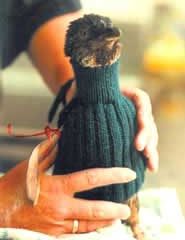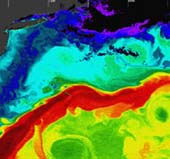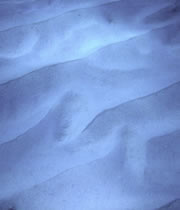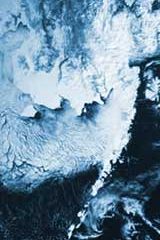Life on the moons of Jupiter, and a source of healthy polyunsaturated fatty acids and low temperature enzymes that could even make washing powders work at low temperatures: The microbes that live in Antarctic sea ice may hold the answers to a host of everyday applications as well as revealing how life forms might be able to exist on frozen planets. One of those interested in sea ice and the life forms it supports is Dr David Thomas of the University`s School of Ocean Sciences. He is presently the on
One of the more controversial environmental issues, which emerged in the final years of the Soviet era, was the plan to dam and reverse the flow of north-flowing rivers in order to irrigate the dry southern steppes. This scheme was roundly criticised by scientists and environmentalists at the time because of fears for the impact on the Arctic Ocean and global climate. It now appears that nature performed this experiment some 90,000 years ago.
This months issue of the Journal of Quaternary

Knitted pullovers protect penguins from oil discharge
Knitters around the world have pulled together to save thousands of oil-soaked little penguins on Phillip Island, southern Australia.
Ten thousand penguin-sized, pure-wool jumpers have flooded into the offices of the Tasmanian Conservation Trust in response to their call for emergency insulation for a vulnerable population of world’s smallest penguins – sometimes known as fairy penguins.
In mid-December 2001 a cru

Argon traces keep tabs on climate change.
A new method for detecting tiny quantities of a rare form of the element argon may help oceanographers to trace the vast undersea currents that regulate our planet’s climate.
The technique can pick out one atom of the rare isotope argon-39 (39Ar) amid 10 million billion other atoms. That’s equivalent to detecting less than a litre of water in America’s 300-mile Lake Michigan.
Philippe Collon, a nuclear physicist at the Lamon

Researchers name the microbes that could produce power by munching pollution.
Bacteria could clear up oil spills and generate electricity at the same time. US scientists have identified microbes that produce power as they digest organic waste 1 .
The bacteria strip electrons from carbon in ocean sediments to convert it into the carbon dioxide they need for metabolism and growth. Usually the organisms just dump the electrons onto iron or sulphate minerals on

Natural randomness punctuated past ice ages with warm spells.
Natural randomness in the world’s climate system may have caused the frequent, fast and fleeting returns to warm conditions during past ice ages, say two German scientists 1 .
Andrey Ganopolski and Stefan Rahmstorf at the Potsdam Institute for Climate Impact Research think that the flickering character of ice-age climate is a signature of stochastic resonance. This is the counter-intuitive phenome